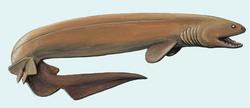Frill Shark

Common name: Frill shark
Scientific name: Chlamydoselachus anguineus
Description
Frilled sharks are bottom dwellers and may contribute to removing decomposing carcasses. This carrion floats down from the open waters of the ocean above and comes to rest on the ocean floor.Today, frilled sharks are the only living species in the family Chlamydoselachidae(Sheikh-Miller, 2001).
Range & Habitat
Frill Sharks have been found almost worldwide, including the eastern Atlantic coast of northern Norway, the western Indian Ocean near South Africa, the western Pacific near New Zealand, and the eastern Pacific near the coast of Chile.
Chlamydoselachus anguineus, is found on continental shelves and the nearshore areas of large islands, although they are occasionally reported in open waters. They are mostly benthic and occur at depths from 100 to 1,300 meters.
Food
Because of their sharp, cuspidate teeth, it is thought that their primary foods are small deep-water fishes, and squid. Because frilled sharks live on the ocean floor, they may also feed on carrion floating down from the surface.
Nature & Reproduction
Nature:Frilled sharks have a long slender body with an elongate tail fin, giving them an eel-like appearance (Compagno, 1984). The body tends to be a chocolate brown color. They have a small dorsal fin located well towards the tail, above the large anal fin, and in front of the highly asymmetric caudal fin. The pectoral fins are short and rounded.
Reproduction:These sharks have the ability to breed all year.Fertilization in all sharks is internal, taking place in the egg tubes or oviducts of the female. Male sharks must grab females, maneuver their bodies so that he can introduce his claspers to pass sperm into the vent. Males and females come together only to mate.Females apparently reproduce all year long and have a gestation period of about one to two years.
 Deep Sea Crabs
Deep Sea Crabs